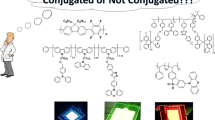Abstract
High efficient polymer light-emitting diodes (PLEDs) were obtained by using a blend of conjugated polymer G-PF, a copolymer of fluorene and thiophene, and polystyrene (PS). The maximum electroluminescent (EL) efficiency of the device is 12 cd/A when G-PF/PS weight ratio is at 80/20, while that of pure G-PF device is 6.5 cd/A. Studies on photoluminescence and electroluminescence of the blends indicate that inter-chain interactions were tremendously suppressed due to the dilution effect. However, after PS concentration exceeds 20% the EL efficiency of the devices decreases with further increase of PS concentration. This may be due to the decrease of the recombination probability of electrons and holes with the excessive addition of PS insulator.
Similar content being viewed by others
References
Adachi, C, Tsutsui, T, Saito, S., Blue light-emitting organic electroluminescent devices, Applied Physics Letters, 1990, 56(9): 799–801.
Burroughes, J. H, Bradley, D. D. C, Brown, A. R. et al., Lightemitting diodes based on conjugated polymers, Nature, 1990, 347(6293): 539–541.
Braun, D, Heeger, A. J, Kroemer, H., Improved efficiency in semiconducting polymer light-emitting diodes, Journal of Electronic Materials, 1991, 20(11): 945–948.
Gustafsson, G, Cao, Y, Treacy, G. M. et al., Flexible light-emitting diodes made from soluble conducting polymers, Nature, 1992, 357(6378): 477–479.
Wasey, J. A. E, Safonov, A, Samuel, I. D. W. et al., Efficiency of radiative emission from thin films of a light-emitting conjugated polymer, Physical Review B (Condensed Matter and Materials Physics), 2001, 64(20): 205201–205209.
Guo, T. F, Pyo, S, Chang, S. C. et al., High performance polymer light-emitting diodes fabricated by a low temperature lamination process, Advanced Functional Materials, 2001, 11(5): 339–343.
Yan, M, Rothberg, L. J, Papadimitrakopoulos, F. et al., Spatially indirect excitons as primary photoexcitations in conjugated polymers, Physical Review Letters, 1994, 72(7): 1104–1107.
Yan, M, Rothberg, L. J, Kwock, E. W. et al., Interchain excitations in conjugated polymers, Physical Review Letters, 1995, 75(10): 1992–1995.
Hu, B, Zhang, N, Karasz, F. E., Bright red electroluminescence from a dye/copolymer blend, Journal of Applied Physics, 1998, 83(11): 6002–6006.
Sun, B. J, Miao, Y. J, Bazan, G. C. et al., Luminescent behavior of soluble poly(para-phenylene vinylene) copolymers, Chemical Physics Letters, 1996, 260(1–2): 186–190.
Smilowitz, L, Hays, A, Heeger, A. J. et al., Time-resolved photoluminescence from poly(2-methoxy, 5-(2′-ethylhexyloxy)-p-phenylene-vinylene): Solutions, gels, films, and blends, Journal of Chemical Physics, 1993, 98(8): 6504–6509.
He, G, Liu, J, Li, Y. et al., Efficient polymer light-emitting diodes using conjugated polymer blends, Applied Physics Letters, 2002, 80(11): 1891–1893.
Liu, J, Shi, Y, Yang, Y., Improving the performance of polymer light-emitting diodes using polymer solid solutions, Applied Physics Letters, 2001, 79(5): 578–580.
Pinto, M. R, Hu, B, Karasz, F. E. et al., Light-emitting copolymers of cyano-containing PPV-based chromophores and a flexible spacer, Polymer, 2000, 41(7): 2603–2611.
Shi, Y, Liu, J, Yang, Y., Device performance and polymer morphology in polymer light emitting diodes: The control of thin film morphology and device quantum efficiency, Journal of Applied Physics, 2000, 87(9): 4254–4263.
Liu, J, Shi, Y, Ma, L. et al., Device performance and polymer morphology in polymer light emitting diodes: The control of device electrical properties and metal/polymer contact, Journal of Applied Physics, 2000, 88(2): 605–609.
Author information
Authors and Affiliations
Corresponding author
About this article
Cite this article
He, G., Liu, J., Yang, Y. et al. High efficient light-emitting diodes using polystyrene as matrix. Chin.Sci.Bull. 48, 853–855 (2003). https://doi.org/10.1007/BF03325662
Received:
Published:
Issue Date:
DOI: https://doi.org/10.1007/BF03325662




